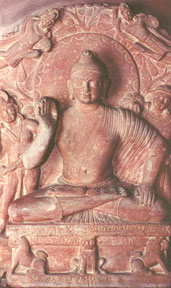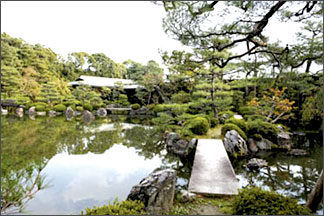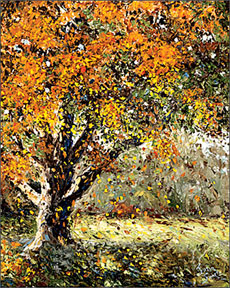|
Buddhist Spectrum
Complex concepts in Buddhism for worldly well-being
Yapa A.D.S.K. Wickramasinghe
|

Seated Buddha - Kushana period. 2nd century AD. Katra mound,
Mathura region, India.
|
It is a well accepted fact that, by following the teachings of The
Buddha, we will be able to lead a decent and peaceful life in this birth
(bhawaya); be assured of a good life after death and more importantly,
we would finally be emancipated from all the worldly sufferings or 'duhkkas'.
It is believed that, teachings of The Buddha are contained in the 'Thripitakaya'
and the 'Abhidharmaya' is the Pitakaya or sector mainly devoted to
discussing the four 'paramartha dhammas' or four major concepts ('Chiththa',
'Chaithasika', 'Nirvana' and 'Rupa') in Buddhism.
Although, the path to Nirvana is through 'Vidharsana' Meditation and
'Saptha Visudhdhiya' as envisaged in the 'Visudhdhi Margaya', a detailed
knowledge of the 'Abidharmaya' is indispensable in this respect. It is
interesting to note that findings and discoveries in modern science are
now in the process of getting closer to the complex concepts enshrined
in the 'Abhidharmaya'.
In 'Vidharshana' meditation, prominence is given to thilakshana
bhavana or meditation on the three Characteristics of 'Sanskara' - the
meditation on 'Anichcha', 'Dukka' and 'Anathma' of the 'Nama' and 'Rupa'.
The 'rupa' is meticulously considered in 'Abhidharmaya', facilitating
this endeavour.
When compared to the other 'paramartha dhammas', the 'rupa' is less
complex in 'Abhidharmaya' and therefore let's try to consider this in
some detail. The Buddhist texts consider 'Rupa Kalapa' or matter zones -
formed by the combination of the four basic elements - 'patavi', 'apo',
'thejo' and 'wayo' - as the smallest form of matter.
This is not only different from the atom that is explained in
science, but also much more smaller than the atom. An atom is supposed
to contain many 'rupa kalapas'. However, the atom was, a few decades
back, considered in science as the smallest form of matter and
indivisible - no further division was possible. (Interestingly enough,
if we take time to refer to the 'Yogachara Bhumishasthraya' related to
the Mahayana sector, it would not be difficult to find that the
contemporary 'Theory of the Permanence/the Indivisibility of the Atom'
had been shattered thousands of years ago!)
Another few decades passed before it was discovered that the atom in
fact had three sub - atomic particles - the proton, neutron and
electron. Later on, more sub-atomic particles were discovered.
Judging by the emergence of new discoveries, eventually, it will be
discovered that even the sub-atomic particles are made of something even
smaller - most probably made of the rupa kalapas discussed in
Abhidharmaya. Another attribute of the 'rupa kalapa' is its very brief
existence.
It takes only a split second for the 'rupa kalapa' to come into being
('uthpada'), exist ('sthithi) and cease ('bhanga') in quick succession.
Originally, the atom or sub - atomic particles were not supposed to
possess this characteristic.
However, it has been discovered recently that, there really exists an
extremely short-lived atom like entity, comprising both matter and
antimatter. Therefore, it appears that, the brief existence of a super
small matter ('rupa kalapa') mentioned in the teachings of The Buddha,
more than two thousand five hundred years back is now being established
scientifically.
Even the tiniest particle of matter has millions of 'rupa kalapas'.
As the 'rupa kalapa' in its cessation gives birth to another similar set
of 'rupa kalapas', a dynamic equilibrium is maintained - at a given
moment -in a given particle and as a result of this, a significant
diminishing of matter or change of matter cannot be observed in short
time.
However, when the living organisms get older, this re-creation or
reproduction ability of the 'rupa kalapas' becomes weak due to a number
of reasons, breaking the apparent equilibrium mentioned above,
exhibiting a marked change in matter and that is where the ageing
process becomes externally visible.
This extremely short-lived nature of the 'rupa kalapa' and the
influence of external agents ('prathya) on the new production of 'rupa
kalapa' explain why the tissues of living organisms change or deform -
sometimes causing diseases - due to external factors like ultra violet
rays, chemicals, physical contact, lack of nutrition etc.
The fact that; 'the ability of external agents to modify the nature
of the tissues is due to the attributes of the 'rupa kalapa", as
detailed in Buddhist text, can be very useful in science including the
medical science.
There is a lesson for us too. Care must be taken in exposing (or over
exposing) our bodies or organs to unfamiliar and untested external
agents ('prathya'), because these can affect the cell structure, due to
'rupa kalapa' deformations, causing unnecessary problems. The same could
be true with respect to exposing our mind also to unsuitable 'prathyas'!
This is an area worth discussing in detail in future.
Details related to the nature of 'rupa' found in 'Abhidharmaya',
significantly facilitates the much emphasized 'Thilakshana Meditation'
('aniththa', 'duhkka' and 'anaththa') in 'Vidharshana'.
However, this brief discussion above on just one topic from the 'Abhidharmaya'
clearly indicates how beneficial the teachings of The Buddha could be,
for the well-being of the human beings even with respect to his worldly
('lowkika') matters.
An in-depth study of the other more complex 'Paramartha Dharma',
specially the 'chiththa' and 'chaithasikha' which are directly related
to the human mind would be more beneficial for human beings, who are now
in the fast track towards 'development', paying minimal or least
attention to this important entity - the mind.
The writer is a former Director of Education.
Taking refuge in the three treasures
John Daido Loori, Roshi
When I listen to the precepts, the vows, and the service dedications,
when I feel my body in the bows, when I connect with the Buddhas and
ancestors in the daily liturgy, I am touched by an incredible sense of
gratitude for having the opportunity to hear, experience, and
participate in these teachings at this time. I know it is a gift that I
will never be able to repay. It makes me wonder how often any of us
appreciates how profound this practice is.
 Do we really hear it? Do we sense it? Do we feel it with our bones,
right down to the marrow, with every cell in our bodies - or is it just
another fling, a dharma fling? Do we really hear it? Do we sense it? Do we feel it with our bones,
right down to the marrow, with every cell in our bodies - or is it just
another fling, a dharma fling?
It is vitally important to appreciate this life. In one sense, that
is what taking refuge in the Three Treasures really is about,
appreciating our life, appreciating all life, waking up again and again
to that feeling.
People ask, "How can I deepen the teacher-student relationship?" It
is like asking, "How can I love you?" Is there a book of instructions on
how to love? Does the baby get taught how to love its mother, the
flowers, the earth, and the rain? In Zen training we say, "Really put
yourself into it," but what does that mean?
It means to take refuge and to be protected by the Three Treasures?
We chant, "Being one with the Buddha, being one with the Dharma, being
one with the Sangha." Those are the Three Treasures, but what does it
mean to "be one with?" This is what we need to see, to realize clearly
and personally.
The way we use the word refuge is taken from the Japanese term kie-ei.
Kie-ei consists of two characters. Kie means "to unreservedly throw
oneself into," no holding back, no way out, no safety net, harness, or
rope. That is the way you work with a kian - unreservedly. That is the
way a parent rescues a child who is in danger. The parent does not think
about himself or herself.
The parent does not hesitate for a second. The second character, ei,
literally means "to rely upon," in the way that a child leaps into a
parent's arms, trusting unequivocally.
I remember when my children were young. They were able to stand by
themselves but couldn't yet walk, and I would stand them up on the
dresser and say, "Jump!" They would throw themselves into space, knowing
I would be there. They had a complete sense of trust and unwavering
commitment.
 Blossoms among the leaves Blossoms among the leaves
You have seen the blossoms among the leaves;
tell me, how long will they stay?
Today they tremble before the hand that picks them
Tomorrow they wait someone's garden broom
Wonderful is the bright heart of youth
but with the years it grows old
Is the world not like these flowers?
Ruddy faces, how can they last?
Han-Shan
|

